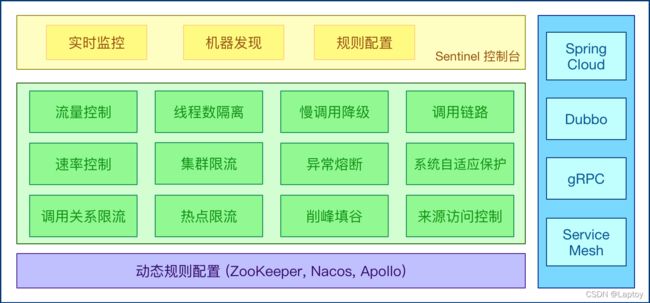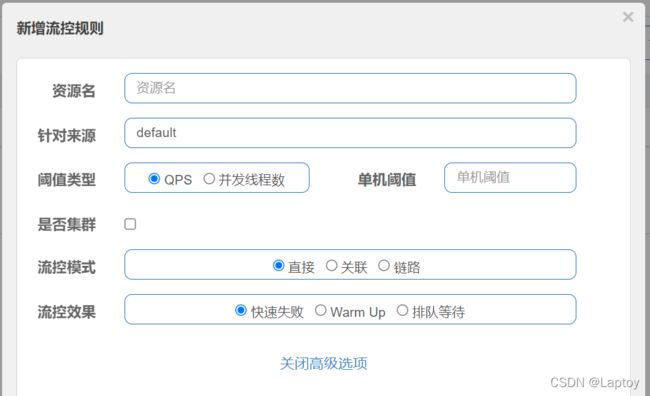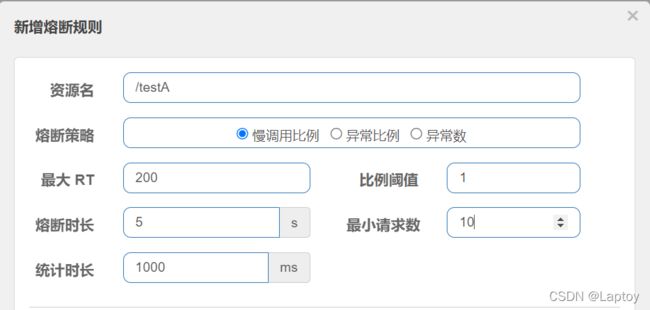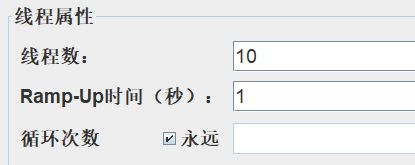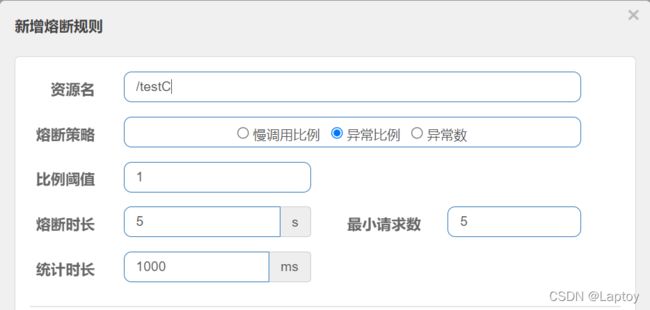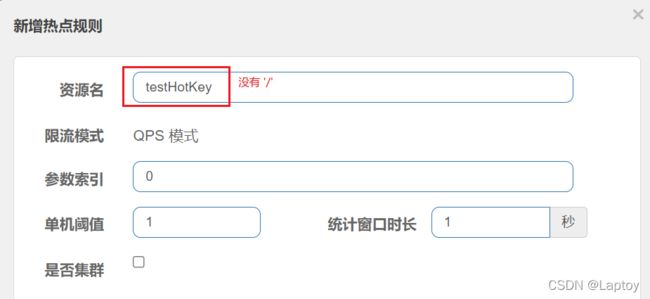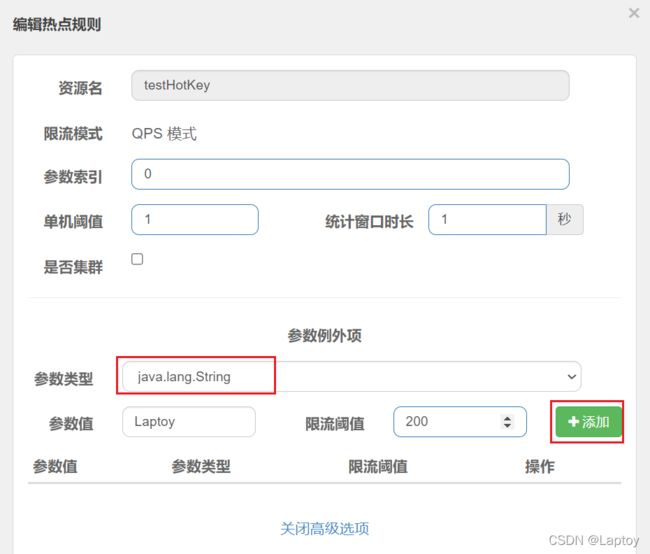3 - 分布式系统的流量防卫兵:Sentinel
- Java工程师的进阶之旅
- 学习 SpringCloud2 这一篇就够了
- 1 - SpringCloud Alibaba 介绍
- 2 - 服务注册与配置中心:Nacos
- 3 - 分布式系统的流量防卫兵:Sentinel
- 4 - 分布式事务:Seata
目录
- 三、Sentinel
-
- 3.1 - 简介
- 3.2 - 安装
- 3.3 - 初始化监控
- 3.5 - 流控规则
-
- 3.5.1 - 直接(默认)
-
- 3.5.1.1 - QPS直接失败
- 3.5.1.2 - 线程数直接失败
- 3.5.2 - 关联
- 3.5.3 - 预热
- 3.5.4 - 排队等待
- 3.6 - 熔断降级
-
- 3.6.1 - 概述
- 3.6.2 - 熔断策略
-
- 3.6.2.1 - 慢调用比例测试
- 3.6.2.2 - 异常比例测试
- 3.6.2.1 - 异常数测试
- 3.7 - 热点key - 上
- 3.8、热点key - 下
- 3.9、系统规则
- 3.10、SentinelResource配置 - 上
- 3.11、SentinelResource配置 - 中
- 3.12、SentinelResource配置 - 下
- 3.13、服务熔断Ribbon环境
-
- 3.13.1、服务提供者
- 3.13.2、服务消费者
- 3.13.3、配置fallback
- 3.13.4、配置限流
- 3.14.5、配置fallback和限流
- 3.14.6、配置exceptionsToIgnore
- 3.14.7、配置降级
- 3.14、持久化规则
三、Sentinel
3.1 - 简介
官方文档
3.1.1 - 介绍
随着微服务的流行,服务和服务之间的稳定性变得越来越重要。Sentinel 是面向分布式服务架构的流量控制组件,主要以流量为切入点,从流量控制、熔断降级、系统自适应保护等多个维度来帮助您保障微服务的稳定性。
3.1.2 - 概念
1、资源
资源是 Sentinel 的关键概念。它可以是 Java 应用程序中的任何内容,例如,由应用程序提供的服务,或由应用程序调用的其它应用提供的服务,甚至可以是一段代码。在接下来的文档中,我们都会用资源来描述代码块。
只要通过 Sentinel API 定义的代码,就是资源,能够被 Sentinel 保护起来。大部分情况下,可以使用方法签名,URL,甚至服务名称作为资源名来标示资源。
2、规则
围绕资源的实时状态设定的规则,可以包括流量控制规则、熔断降级规则以及系统保护规则。所有规则可以动态实时调整。
3.1.3 - 特征
- 丰富的应用场景:Sentinel 承接了阿里巴巴近 10 年的双十一大促流量的核心场景,例如秒杀(即突发流量控制在系统容量可以承受的范围)、消息削峰填谷、集群流量控制、实时熔断下游不可用应用等。
- 完备的实时监控:Sentinel 同时提供实时的监控功能。您可以在控制台中看到接入应用的单台机器秒级数据,甚至 500 台以下规模的集群的汇总运行情况。
- 广泛的开源生态:Sentinel 提供开箱即用的与其它开源框架/库的整合模块,例如与 Spring Cloud、Dubbo、gRPC 的整合。您只需要引入相应的依赖并进行简单的配置即可快速地接入 Sentinel。
- 完善的 SPI 扩展点:Sentinel 提供简单易用、完善的 SPI 扩展接口。您可以通过实现扩展接口来快速地定制逻辑。例如定制规则管理、适配动态数据源等。
Hystrix与Sentinel比较:
- Hystrix:需要手工搭建监控平台,没有一套web界面可以给我们进行更加细粒度化得配置流控、速率控制、服务熔断、服务降级
- Sentinel:单独一个组件,可以独立出来,直接界面化的细粒度统一配置。
3.1.4 - 功能
1、流量控制
流量控制在网络传输中是一个常用的概念,它用于调整网络包的发送数据。然而,从系统稳定性角度考虑,在处理请求的速度上,也有非常多的讲究。任意时间到来的请求往往是随机不可控的,而系统的处理能力是有限的。我们需要根据系统的处理能力对流量进行控制。Sentinel 作为一个调配器,可以根据需要把随机的请求调整成合适的形状,如下图所示:

流量控制有以下几个角度:
- 资源的调用关系,例如资源的调用链路,资源和资源之间的关系;
- 运行指标,例如 QPS、线程池、系统负载等;
- 控制的效果,例如直接限流、冷启动、排队等。
Sentinel 的设计理念是让您自由选择控制的角度,并进行灵活组合,从而达到想要的效果。
2、熔断降级
除了流量控制以外,降低调用链路中的不稳定资源也是 Sentinel 的使命之一。由于调用关系的复杂性,如果调用链路中的某个资源出现了不稳定,最终会导致请求发生堆积。这个问题和 Hystrix 里面描述的问题是一样的。
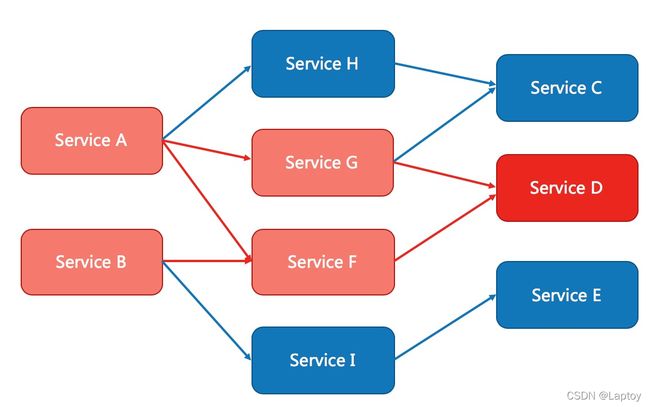
Sentinel 和 Hystrix 的原则是一致的: 当调用链路中某个资源出现不稳定,例如,表现为 timeout,异常比例升高的时候,则对这个资源的调用进行限制,并让请求快速失败,避免影响到其它的资源,最终产生雪崩的效果。
3、熔断降级设计理念
在限制的手段上,Sentinel 和 Hystrix 采取了完全不一样的方法。
Hystrix 通过线程池的方式,来对依赖(在我们的概念中对应资源)进行了隔离。这样做的好处是资源和资源之间做到了最彻底的隔离。缺点是除了增加了线程切换的成本,还需要预先给各个资源做线程池大小的分配。
Sentinel 对这个问题采取了两种手段:
- 通过并发线程数进行限制
和资源池隔离的方法不同,Sentinel 通过限制资源并发线程的数量,来减少不稳定资源对其它资源的影响。这样不但没有线程切换的损耗,也不需要您预先分配线程池的大小。当某个资源出现不稳定的情况下,例如响应时间变长,对资源的直接影响就是会造成线程数的逐步堆积。当线程数在特定资源上堆积到一定的数量之后,对该资源的新请求就会被拒绝。堆积的线程完成任务后才开始继续接收请求。
- 通过响应时间对资源进行降级
除了对并发线程数进行控制以外,Sentinel 还可以通过响应时间来快速降级不稳定的资源。当依赖的资源出现响应时间过长后,所有对该资源的访问都会被直接拒绝,直到过了指定的时间窗口之后才重新恢复。
4、系统负载保护
Sentinel 同时提供系统维度的自适应保护能力。防止雪崩,是系统防护中重要的一环。当系统负载较高的时候,如果还持续让请求进入,可能会导致系统崩溃,无法响应。在集群环境下,网络负载均衡会把本应这台机器承载的流量转发到其它的机器上去。如果这个时候其它的机器也处在一个边缘状态的时候,这个增加的流量就会导致这台机器也崩溃,最后导致整个集群不可用。
针对这个情况,Sentinel 提供了对应的保护机制,让系统的入口流量和系统的负载达到一个平衡,保证系统在能力范围之内处理最多的请求。
3.1.5 - 流程
- 对主流框架提供适配或者显示的 API,来定义需要保护的资源,并提供设施对资源进行实时统计和调用链路分析。
- 根据预设的规则,结合对资源的实时统计信息,对流量进行控制。同时,Sentinel 提供开放的接口,方便您定义及改变规则。
- Sentinel 提供实时的监控系统,方便您快速了解目前系统的状态。
3.2 - 安装
1、Window安装
Java 8 + 8080端口
官网下载jar包
运行 - java -jar sentinel-dashboard-1.8.3.jar
访问 - localhost:8080 (账号密码均为sentinel)
2、Linux之Docker安装
作为扩展:服务器必须和开发机同一台机器才能监控得到数据(这里测试不通过)
docker run --name sentinel-dashboard -p 8080:8080 -p 8719:8719 \
-e port=8080 -e server=localhost:8080 \
-e name=sentinel-dashboard -e username=sentinel -e password=sentinel \
-v /mydata/sentinel/logs:/root/logs/csp/ \
-d aeert/sentinel-dashboard:latest
Sentinel 分为两个部分:
- 核心库(Java 客户端)不依赖任何框架/库,能够运行于所有 Java 运行时环境,同时对 Dubbo / Spring Cloud 等框架也有较好的支持。
- 控制台(Dashboard)基于 Spring Boot 开发,打包后可以直接运行,不需要额外的 Tomcat 等应用容器。
3.3 - 初始化监控
1、新建工程 - cloudalibaba-sentinel-service8401
2、POM
<dependencies>
<dependency>
<groupId>com.alibaba.cloudgroupId>
<artifactId>spring-cloud-starter-alibaba-nacos-discoveryartifactId>
dependency>
<dependency>
<groupId>com.alibaba.cspgroupId>
<artifactId>sentinel-datasource-nacosartifactId>
dependency>
<dependency>
<groupId>com.alibaba.cloudgroupId>
<artifactId>spring-cloud-starter-alibaba-sentinelartifactId>
dependency>
<dependency>
<groupId>org.springframework.cloudgroupId>
<artifactId>spring-cloud-starter-openfeignartifactId>
dependency>
<dependency>
<groupId>com.laptoy.springcloudgroupId>
<artifactId>cloud-api-commonsartifactId>
<version>1.0-SNAPSHOTversion>
dependency>
<dependency>
<groupId>org.springframework.bootgroupId>
<artifactId>spring-boot-starter-webartifactId>
dependency>
<dependency>
<groupId>org.springframework.bootgroupId>
<artifactId>spring-boot-starter-actuatorartifactId>
dependency>
<dependency>
<groupId>org.springframework.bootgroupId>
<artifactId>spring-boot-devtoolsartifactId>
<scope>runtimescope>
<optional>trueoptional>
dependency>
<dependency>
<groupId>cn.hutoolgroupId>
<artifactId>hutool-allartifactId>
<version>4.6.3version>
dependency>
<dependency>
<groupId>org.projectlombokgroupId>
<artifactId>lombokartifactId>
<optional>trueoptional>
dependency>
<dependency>
<groupId>org.springframework.bootgroupId>
<artifactId>spring-boot-starter-testartifactId>
<scope>testscope>
dependency>
dependencies>
3、YML
server:
port: 8401
spring:
application:
name: cloudalibaba-sentinel-service
cloud:
nacos:
discovery:
server-addr: 120.76.55.55:8848 #Nacos服务注册中心地址
sentinel:
transport:
# 前台展示端口
dashboard: 120.76.55.55:8080
# 后台监控端口
port: 8719
# 暴露监控断点
management:
endpoints:
web:
exposure:
include: '*'
feign:
sentinel:
enabled: true # 激活Sentinel对Feign的支持
4、主启动
@EnableDiscoveryClient
@SpringBootApplication
public class MainApp8401 {
public static void main(String[] args) {
SpringApplication.run(MainApp8401.class, args);
}
}
5、控制类
@RestController
@Slf4j
public class FlowLimitController {
@GetMapping("/testA")
public String testA() {
log.info(Thread.currentThread().getName()+"\t"+"...testA");
return "------testA";
}
@GetMapping("/testB")
public String testB() {
log.info(Thread.currentThread().getName()+"\t"+"...testB");
return "------testB";
}
}
6、测试
启动 - nacos8848、sentinel8080、8401微服务
查看 - localhost:8080(空空如也) - Sentinel采用懒加载
执行一次访问即可 - http://localhost:8401/testA - http://localhost:8401/testB
3.5 - 流控规则
- 资源名:唯一名称,默认请求路径。
- 针对来源:Sentinel可以针对调用者进行限流,填写微服务名,默认default(不区分来源)。
- 阈值类型/单机阈值:
- QPS(每秒钟的请求数量)︰当调用该API的QPS达到阈值的时候,进行限流。
- 线程数:当调用该API的线程数达到阈值的时候,进行限流。
- 是否集群:不需要集群。
- 流控模式:
- 直接:API达到限流条件时,直接限流。
- 关联:当关联的资源达到阈值时,就限流自己。
- 链路:只记录指定链路上的流量(指定资源从入口资源进来的流量,如果达到阈值,就进行限流)【API级别的针对来源】。
- 流控效果:
- 快速失败:直接失败,抛异常。
- Warm up:根据Code Factor(冷加载因子,默认3)的值,从阈值/codeFactor,经过预热时长,才达到设置的QPS阈值。
- 排队等待:匀速排队,让请求以匀速的速度通过,阈值类型必须设置为QPS,否则无效。
3.5.1 - 直接(默认)
3.5.1.1 - QPS直接失败
表示1秒钟内查询 1 次(阈值)就是OK,若超过次数1,就直接->快速失败,报默认错误

测试:快速多次访问 - http://localhost:8401/testA
结果:返回页面 Blocked by Sentinel (flow limiting)
直接调用默认报错信息,技术方面OK,但应该有我们自己的后续处理?类似有个fallback的兜底方法?
3.5.1.2 - 线程数直接失败
当调用该API的线程数达到阈值的时候,进行限流

/testB 请求模拟线程睡眠了1秒 添加代码 - Thread.sleep(1000);
测试1:间隔1秒访问1次 - http://localhost:8401/testB - 正常访问
测试2:1秒内快速两次访问 - http://localhost:8401/testB - 第二次请求进来直接报错
3.5.2 - 关联
当与自己关联的资源达到阈值时,就限流自己
设置效果:当与A关联的资源B达到阀值后,就限流A自己 - 同生共死(先删除之前的所有规则)
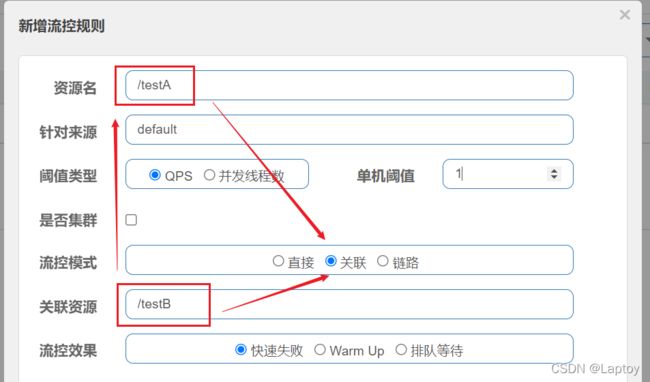
使用PostMan模拟并发密集访问testB

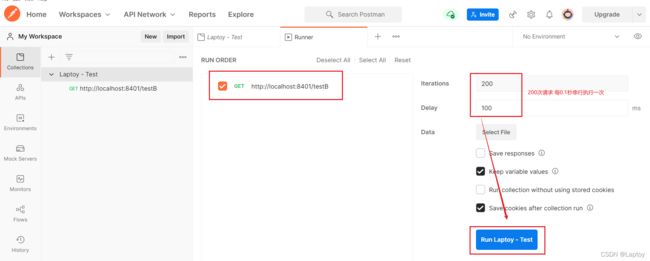
点击执行 - /testB 密集访问后访问 http://localhost:8401/testA - 直接报错
3.5.3 - 预热
Warm Up(RuleConstant.CONTROL_BEHAVIOR_WARM_UP)方式,即预热/冷启动方式。当系统长期处于低水位的情况下,当流量突然增加时,直接把系统拉升到高水位可能瞬间把系统压垮。通过"冷启动",让通过的流量缓慢增加,在一定时间内逐渐增加到阈值上限,给冷系统一个预热的时间,避免冷系统被压垮。
详细文档可以参考 流量控制 - Warm Up 文档,具体的例子可以参见 WarmUpFlowDemo。
通常冷启动的过程系统允许通过的 QPS 曲线如下图所示:
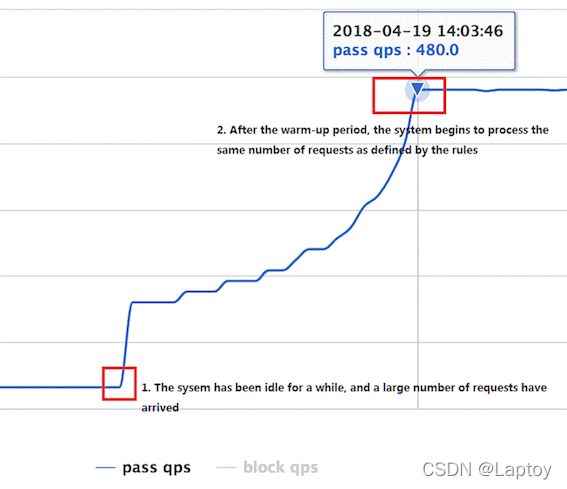
默认coldFactor(冷启动因子)为3,即请求阈值 从 QPS / 3开始,经预热时长逐渐升至设定的QPS阈值
案例:阀值为10 + 预热时长5秒
系统初始化的阀值为 10 / 3 约等于3,即阀值刚开始为3,5秒内阀值慢慢升高恢复到10

测试:多次快速点击 - http://localhost:8401/testA - 刚开始偶尔报错,后续慢慢OK
应用场景:秒杀系统在开启的瞬间,会有很多流量上来,很有可能把系统打死,预热方式就是把为了保护系统,可慢慢的把流量放进来,慢慢的把阀值增长到设置的阀值。
3.5.4 - 排队等待
匀速排队,让请求以均匀的速度通过,阀值类型必须设成QPS,否则无效
设置 - /testA 每秒1次请求,超过的话就排队等待 - (超时时间为20000毫秒)

详细介绍:流量控制 - 匀速器模式
匀速排队(RuleConstant.CONTROL_BEHAVIOR_RATE_LIMITER)方式会严格控制请求通过的间隔时间,也即是让请求以均匀的速度通过,对应的是漏桶算法,该方式的作用如下图所示:
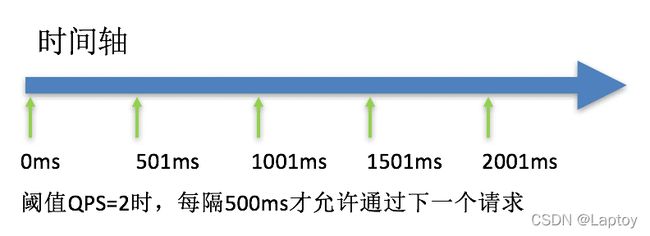
这种方式主要用于处理间隔性突发的流量,例如消息队列。想象一下这样的场景,在某一秒有大量的请求到来,而接下来的几秒则处于空闲状态,我们希望系统能够在接下来的空闲期间逐渐处理这些请求,而不是在第一秒直接拒绝多余的请求。
注意:匀速排队模式暂时不支持 QPS > 1000 的场景
测试:Postman模拟并发密集访问 /testA
3.6 - 熔断降级
3.6.1 - 概述
官方文档
注意:本文档针对 Sentinel 1.8.0 及以上版本。1.8.0 版本对熔断降级特性进行了全新的改进升级,请使用最新版本以更好地利用熔断降级的能力。
除了流量控制以外,对调用链路中不稳定的资源进行熔断降级也是保障高可用的重要措施之一。一个服务常常会调用别的模块,可能是另外的一个远程服务、数据库,或者第三方 API 等。例如,支付的时候,可能需要远程调用银联提供的 API;查询某个商品的价格,可能需要进行数据库查询。然而,这个被依赖服务的稳定性是不能保证的。如果依赖的服务出现了不稳定的情况,请求的响应时间变长,那么调用服务的方法的响应时间也会变长,线程会产生堆积,最终可能耗尽业务自身的线程池,服务本身也变得不可用。

现代微服务架构都是分布式的,由非常多的服务组成。不同服务之间相互调用,组成复杂的调用链路。以上的问题在链路调用中会产生放大的效果。复杂链路上的某一环不稳定,就可能会层层级联,最终导致整个链路都不可用。因此我们需要对不稳定的弱依赖服务调用进行熔断降级,暂时切断不稳定调用,避免局部不稳定因素导致整体的雪崩。熔断降级作为保护自身的手段,通常在客户端(调用端)进行配置。
3.6.2 - 熔断策略
- 慢调用比例:
- 设置允许的慢调用 RT(即最大的响应时间),请求的响应时间大于该值则统计为慢调用
- 当单位统计时长内请求数目大于设置的最小请求数目,并且慢调用的比例大于阈值,则接下来的熔断时长内请求会自动被熔断。
- 经过熔断时长后熔断器会进入探测恢复状态(HALF-OPEN 状态),若接下来的一个请求响应时间小于设置的慢调用 RT 则结束熔断,若大于设置的慢调用 RT 则会再次被熔断。
- 异常比例:
- 当单位统计时长内请求数目大于设置的最小请求数目,并且异常的比例大于阈值,则接下来的熔断时长内请求会自动被熔断。
- 异常比率的阈值范围是 [0.0, 1.0],代表 0% - 100%。
- 经过熔断时长后熔断器会进入探测恢复状态(HALF-OPEN 状态),若接下来的一个请求成功完成(没有错误)则结束熔断,否则会再次被熔断。
- 异常数 :
- 当单位统计时长内的异常数目超过阈值之后会自动进行熔断
- 经过熔断时长后熔断器会进入探测恢复状态(HALF-OPEN 状态),若接下来的一个请求成功完成(没有错误)则结束熔断,否则会再次被熔断。
3.6.2.1 - 慢调用比例测试
测试 - 请求 testA 添加 TimeUnit.SECONDS.sleep(1); 模拟调用时间大于最大RT
3.6.2.2 - 异常比例测试
FlowLimitController 控制层 - 新增
@RestController
@Slf4j
public class FlowLimitController {
...
@GetMapping("/testC")
public String testC() {
int age = 10/0;
return "------testC";
}
}
按照上述配置,手动访问一次,调一次错一次error。
使用 JMeter测试,直接高并发发送请求,多次调用达到我们的配置条件了。断路器开启(保险丝跳闸),微服务不可用了,手动访问不再报错error而是服务降级了。

3.6.2.1 - 异常数测试
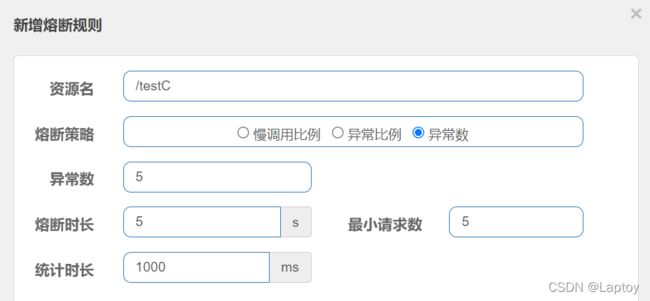
访问 - http://localhost:8401/testC,第一次访问绝对报错,因为除数不能为零,我们看到error窗口,但是达到5次报错后,进入熔断后降级。
3.7 - 热点key - 上
何为热点?热点即经常访问的数据。很多时候我们希望统计某个热点数据中访问频次最高的 Top K 数据,并对其访问进行限制。比如:
- 商品 ID 为参数,统计一段时间内最常购买的商品 ID 并进行限制
- 用户 ID 为参数,针对一段时间内频繁访问的用户 ID 进行限制
热点参数限流会统计传入参数中的热点参数,并根据配置的限流阈值与模式,对包含热点参数的资源调用进行限流。热点参数限流可以看做是一种特殊的流量控制,仅对包含热点参数的资源调用生效。

Sentinel 利用 LRU 策略统计最近最常访问的热点参数,结合令牌桶算法来进行参数级别的流控。热点参数限流支持集群模式。
拓展1:
之前限流出问题后,都是用sentinel系统默认的提示: Blocked by Sentinel (flow limiting)
使用 @SentinelResource 自定义兜底方法
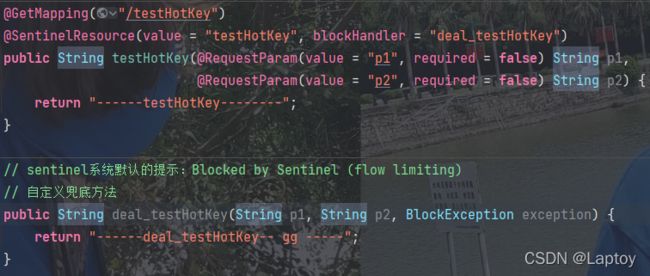
1、兜底方法参数要跟原方法一致并且有BlockException exception参数
2、value需要跟@RequestMapping的路径不一样
3、value是热点规则的资源名

拓展2:
如果是程序的异常:(假设在程序内添加 int i = 10 / 0)
将会抛出Spring Boot 2的默认异常页面,而不是兜底方法。
@SentinelResource - 处理的是sentinel控制台配置的违规情况,有blockHandler方法配置的兜底处理;
RuntimeException int age = 10/0,这个是java运行时报出的运行时异常RunTimeException,@SentinelResource不管
总结 - @SentinelResource主管配置出错,运行出错该走异常走异常
演示:
1、FlowLimitController - 新增
@RestController
@Slf4j
public class FlowLimitController {
...
@GetMapping("/testHotKey")
@SentinelResource(value = "testHotKey",blockHandler = "deal_testHotKey")
public String testHotKey(@RequestParam(value = "p1",required = false) String p1,
@RequestParam(value = "p2",required = false) String p2) {
return "------testHotKey--------";
}
// sentinel系统默认的提示:Blocked by Sentinel (flow limiting)
// 自定义兜底方法
public String deal_testHotKey (String p1, String p2, BlockException exception) {
return "------deal_testHotKey-- gg -----";
}
}
3、测试:
异常访问 - http://localhost:8401/testHotKey?p1=1 - 存在热点key
异常访问 - http://localhost:8401/testHotKey?p1=1&p2=1 - 存在热点key
正常访问 - http://localhost:8401/testHotKey?p2=1 - 不存在热点key
3.8、热点key - 下
上述案例演示了参数p1,当QPS超过1秒1次点击后马上被限流。
参数例外项
- 普通值 - 超过1秒钟一个后,达到阈值1后马上被限流
- 设置参数是某个特殊值时,限流值和平时不一样
- 特例值 - 假如当值等于 Laptoy 时,它的阈值可以达到200
测试:
- 正常访问 -
http://localhost:8401/testHotKey?p1=Laptoy- 存在特殊值 - 异常访问 -
http://localhost:8401/testHotKey?p1=1- 存在热点值 - 当p1值等于 Laptoy 的时候,阈值变为200
- 当p1值不等于 Laptoy 的时候,阈值就是平常的1
3.9、系统规则
系统自适应限流
Sentinel 系统自适应限流从整体维度对应用入口流量进行控制,结合应用的 Load、CPU 使用率、总体平均 RT、入口 QPS 和并发线程数等几个维度的监控指标,通过自适应的流控策略,让系统的入口流量和系统的负载达到一个平衡,让系统尽可能跑在最大吞吐量的同时保证系统整体的稳定性
系统保护规则是从应用级别的入口流量进行控制,从单台机器的 load、CPU 使用率、平均 RT、入口 QPS 和并发线程数等几个维度监控应用指标,让系统尽可能跑在最大吞吐量的同时保证系统整体的稳定性。
系统保护规则是应用整体维度的,而不是资源维度的,并且仅对入口流量生效。入口流量指的是进入应用的流量(EntryType.IN),比如 Web 服务或 Dubbo 服务端接收的请求,都属于入口流量。
系统规则支持以下的模式:
- Load 自适应(仅对 Linux/Unix-like 机器生效):系统的 load1 作为启发指标,进行自适应系统保护。当系统 load1 超过设定的启发值,且系统当前的并发线程数超过估算的系统容量时才会触发系统保护(BBR 阶段)。系统容量由系统的 maxQps * minRt 估算得出。设定参考值一般是 CPU cores * 2.5。
- CPU usage(1.5.0+ 版本):当系统 CPU 使用率超过阈值即触发系统保护(取值范围 0.0-1.0),比较灵敏。
- 平均 RT:当单台机器上所有入口流量的平均 RT 达到阈值即触发系统保护,单位是毫秒。
- 并发线程数:当单台机器上所有入口流量的并发线程数达到阈值即触发系统保护。
- 入口 QPS:当单台机器上所有入口流量的 QPS 达到阈值即触发系统保护。
3.10、SentinelResource配置 - 上
测试1:
cloudalibaba-sentinel-service8401 - 新增配置
关于下面两个实体类哪里来的去看看 SpringCloud2的简介与工程创建 工程重构
1、新增 - 控制层
@RestController
public class RateLimitController {
@GetMapping("/byResource")
@SentinelResource(value = "byResource",blockHandler = "handleException")
public CommonResult byResource() {
return new CommonResult(200,"按资源名称限流测试OK",new Payment(2022L,"serial001"));
}
public CommonResult handleException(BlockException exception) {
return new CommonResult(444,exception.getClass().getCanonicalName()+"\t 服务不可用");
}
}
3、新增 - 流控规则 (通过value值进行限流时才会执行自定义兜底方法)
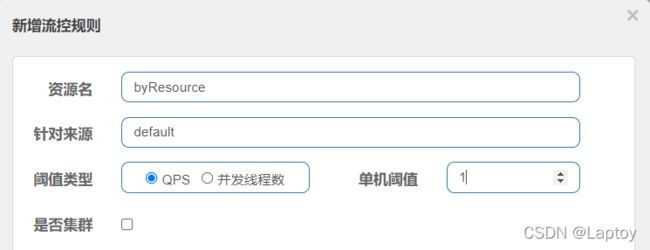
4、测试
启动 - nacos8848、服务8401、sentinel
访问 - http://localhost:8401/byResource 超过设置的流控规则则报错
{"code":444, "message":"com.alibaba.csp.sentinel.slots.block.flow.FlowException\t 服务不可用", "data":null}
5、额外问题
此时关闭问服务8401 -> Sentinel控制台,流控规则消失了
测试2:
1、控制层 - 新增
@RestController
public class RateLimitController {
...
@GetMapping("/rateLimit/byUrl")
@SentinelResource(value = "byUrl")
public CommonResult byUrl() {
return new CommonResult(200,"按url限流测试OK",new Payment(2020L,"serial002"));
}
}
2、流控规则 - 新增 (通过url进行限流)
通过 url进行限流,即使自定义了兜底方法,仍然还是执行sentinel默认的错误提示
3、上述都存在问题
- 系统默认的,没有体现我们自己的业务要求。
- 依照现有条件,我们自定义的处理方法又和业务代码耦合在一块,不直观。
- 每个业务方法都添加—个兜底的,那代码膨胀加剧。
- 全局统—的处理方法没有体现。
3.11、SentinelResource配置 - 中
自定义限流处理类
1、创建CustomerBlockHandler类用于自定义限流处理逻辑
public class CustomerBlockHandler {
public static CommonResult handlerException1(BlockException exception) {
return new CommonResult(4444,"按客戶自定义,global handlerException----1");
}
public static CommonResult handlerException2(BlockException exception) {
return new CommonResult(4444,"按客戶自定义,global handlerException----2");
}
}
2、新增 - 控制类
@RestController
public class RateLimitController {
...
@GetMapping("/rateLimit/customerBlockHandler")
@SentinelResource(value = "customerBlockHandler",
blockHandlerClass = CustomerBlockHandler.class,//<-------- 自定义限流处理类
blockHandler = "handlerException1")//<-----------
public CommonResult customerBlockHandler() {
return new CommonResult(200,"按客戶自定义",new Payment(2020L,"serial003"));
}
}
访问 - http://localhost:8401/rateLimit/customerBlockHandler (一秒内多次访问返回自定义兜底方法)
3.12、SentinelResource配置 - 下
@SentinelResource 注解:注解方式埋点不支持 private 方法。
@SentinelResource 用于定义资源,并提供可选的异常处理和 fallback 配置项。 @SentinelResource 注解包含以下属性:
- value:资源名称,必需项(不能为空)
- entryType:entry 类型,可选项(默认为 EntryType.OUT)
- blockHandler / blockHandlerClass: blockHandler 对应处理 BlockException 的函数名称,可选项。
- blockHandler 函数访问范围需要是 public,返回类型需要与原方法相匹配,参数类型需要和原方法相匹配并且最后加一个额外的参数,类型为 BlockException。blockHandler 函数默认需要和原方法在同一个类中。若希望使用其他类的函数,则可以指定 blockHandlerClass 为对应的类的 Class 对象,注意对应的函数必需为 static 函数,否则无法解析。
- fallback /fallbackClass:fallback 函数名称,可选项,用于在抛出异常的时候提供 fallback 处理逻辑。fallback 函数可以针对所有类型的异常(除了exceptionsToIgnore里面排除掉的异常类型)进行处理。fallback 函数签名和位置要求:
- 返回值类型必须与原函数返回值类型一致;
- 方法参数列表需要和原函数一致,或者可以额外多一个 Throwable 类型的参数用于接收对应的异常。
- fallback 函数默认需要和原方法在同一个类中。若希望使用其他类的函数,则可以指定 fallbackClass 为对应的类的 Class 对象,注意对应的函数必需为 static 函数,否则无法解析。
- defaultFallback(since 1.6.0):默认的 fallback 函数名称,可选项,通常用于通用的 fallback 逻辑(即可以用于很多服务或方法)。默认 fallback 函数可以针对所有类型的异常(除了exceptionsToIgnore里面排除掉的异常类型)进行处理。若同时配置了 fallback 和 defaultFallback,则只有 fallback 会生效。defaultFallback 函数签名要求:
- 返回值类型必须与原函数返回值类型一致;
- 方法参数列表需要为空,或者可以额外多一个 Throwable 类型的参数用于接收对应的异常。
- defaultFallback 函数默认需要和原方法在同一个类中。若希望使用其他类的函数,则可以指定 fallbackClass 为对应的类的 Class 对象,注意对应的函数必需为 static 函数,否则无法解析。
- exceptionsToIgnore(since 1.6.0):用于指定哪些异常被排除掉,不会计入异常统计中,也不会进入 fallback 逻辑中,而是会原样抛出
Sentinel主要有三个核心Api:
- SphU定义资源
- Tracer定义统计
- ContextUtil定义了上下文
3.13、服务熔断Ribbon环境
sentinel整合ribbon+openFeign+fallback
3.13.1、服务提供者
1、新建提供者9003 - cloudalibaba-provider-payment9003
2、POM
<dependencies>
<dependency>
<groupId>com.alibaba.cloudgroupId>
<artifactId>spring-cloud-starter-alibaba-nacos-discoveryartifactId>
dependency>
<dependency>
<groupId>com.laptoy.springcloudgroupId>
<artifactId>cloud-api-commonsartifactId>
<version>${project.version}version>
dependency>
<dependency>
<groupId>org.springframework.bootgroupId>
<artifactId>spring-boot-starter-webartifactId>
dependency>
<dependency>
<groupId>org.springframework.bootgroupId>
<artifactId>spring-boot-starter-actuatorartifactId>
dependency>
<dependency>
<groupId>org.springframework.bootgroupId>
<artifactId>spring-boot-devtoolsartifactId>
<scope>runtimescope>
<optional>trueoptional>
dependency>
<dependency>
<groupId>org.projectlombokgroupId>
<artifactId>lombokartifactId>
<optional>trueoptional>
dependency>
<dependency>
<groupId>org.springframework.bootgroupId>
<artifactId>spring-boot-starter-testartifactId>
<scope>testscope>
dependency>
dependencies>
3、YML
server:
port: 9003
spring:
application:
name: nacos-payment-provider
cloud:
nacos:
discovery:
server-addr: localhost:8848 #配置Nacos地址
management:
endpoints:
web:
exposure:
include: '*'
4、主启动
@SpringBootApplication
@EnableDiscoveryClient
public class PaymentMain9003 {
public static void main(String[] args) {
SpringApplication.run(PaymentMain9003.class, args);
}
}
5、控制层
@RestController
public class PaymentController {
@Value("${server.port}")
private String serverPort;
//模拟数据库
public static HashMap<Long,Payment> hashMap = new HashMap<>();
static {
hashMap.put(1L,new Payment(1L,"28a8c1e3bc2742d8848569891fb42181"));
hashMap.put(2L,new Payment(2L,"bba8c1e3bc2742d8848569891ac32182"));
hashMap.put(3L,new Payment(3L,"6ua8c1e3bc2742d8848569891xt92183"));
}
@GetMapping(value = "/paymentSQL/{id}")
public CommonResult<Payment> paymentSQL(@PathVariable("id") Long id) {
Payment payment = hashMap.get(id);
CommonResult<Payment> result = new CommonResult(200,"from mysql,serverPort: "+serverPort,payment);
return result;
}
}
6、按9003的模板创建 - cloudalibaba-provider-payment9004
7、测试
访问 - http://localhost:9003/paymentSQL/1
访问 - http://localhost:9004/paymentSQL/1
3.13.2、服务消费者
1、新建消费者84 - cloudalibaba-consumer-nacos-order84
2、POM
<dependencies>
<dependency>
<groupId>org.springframework.cloudgroupId>
<artifactId>spring-cloud-starter-openfeignartifactId>
dependency>
<dependency>
<groupId>com.alibaba.cloudgroupId>
<artifactId>spring-cloud-starter-alibaba-nacos-discoveryartifactId>
dependency>
<dependency>
<groupId>com.alibaba.cloudgroupId>
<artifactId>spring-cloud-starter-alibaba-sentinelartifactId>
dependency>
<dependency>
<groupId>com.laptoy.springcloudgroupId>
<artifactId>cloud-api-commonsartifactId>
<version>${project.version}version>
dependency>
<dependency>
<groupId>org.springframework.bootgroupId>
<artifactId>spring-boot-starter-webartifactId>
dependency>
<dependency>
<groupId>org.springframework.bootgroupId>
<artifactId>spring-boot-starter-actuatorartifactId>
dependency>
<dependency>
<groupId>org.springframework.bootgroupId>
<artifactId>spring-boot-devtoolsartifactId>
<scope>runtimescope>
<optional>trueoptional>
dependency>
<dependency>
<groupId>org.projectlombokgroupId>
<artifactId>lombokartifactId>
<optional>trueoptional>
dependency>
<dependency>
<groupId>org.springframework.bootgroupId>
<artifactId>spring-boot-starter-testartifactId>
<scope>testscope>
dependency>
dependencies>
3、YML
server:
port: 84
spring:
application:
name: nacos-order-consumer
cloud:
nacos:
discovery:
server-addr: localhost:8848
sentinel:
transport:
#配置Sentinel dashboard地址
dashboard: localhost:8080
#默认8719端口,假如被占用会自动从8719开始依次+1扫描,直至找到未被占用的端口
port: 8719
# 激活Sentinel对Feign的支持
feign:
sentinel:
enabled: true
4、主启动
@EnableDiscoveryClient
@SpringBootApplication
@EnableFeignClients(basePackages = "com.laptoy.springcloud.service")
public class OrderNacosMain84 {
public static void main(String[] args) {
SpringApplication.run(OrderNacosMain84.class, args);
}
}
5、Feign业务
@FeignClient(value = "nacos-payment-provider")
public interface PaymentService {
@GetMapping(value = "/paymentSQL/{id}")
public CommonResult<Payment> paymentSQL(@PathVariable("id") Long id);
}
6、控制层
@RestController
@Slf4j
public class CircleBreakerController {
@Resource
private PaymentService paymentService;
@RequestMapping("/consumer/fallback/{id}")
@SentinelResource(value = "myFallback")
public CommonResult<Payment> fallback(@PathVariable Long id) {
CommonResult<Payment> result = paymentService.paymentSQL(id);
if (id == 4) {
throw new IllegalArgumentException("非法参数异常....");
}
return result;
}
}
7、测试
控制层无任何异常配置
访问 - http://localhost:84/consumer/fallback/4 (前台直接异常 - 不友好)
访问 - http://localhost:84/consumer/fallback/1 (正常访问)
3.13.3、配置fallback
1、 修改 - 控制层
@RestController
@Slf4j
public class CircleBreakerController {
@Resource
private PaymentService paymentService;
@RequestMapping("/consumer/fallback/{id}")
@SentinelResource(value = "myRule", fallback = "handlerFallback")
public CommonResult<Payment> fallback(@PathVariable Long id) {
CommonResult<Payment> result = paymentService.paymentSQL(id);
if (id == 4) {
throw new IllegalArgumentException("非法参数异常....");
}
return result;
}
// 本例是fallback
public CommonResult handlerFallback(@PathVariable Long id, Throwable e) {
Payment payment = new Payment(id, "null");
return new CommonResult<>(444, "发生异常:" + e.getMessage(), payment);
}
}
2、测试
访问 - http://localhost:84/consumer/fallback/4 (熔断并返回自定义兜底方法)

访问 - http://localhost:84/consumer/fallback/1 (正常访问)

3.13.4、配置限流
1、修改 - 控制层
@RestController
@Slf4j
public class CircleBreakerController {
@Resource
private PaymentService paymentService;
@RequestMapping("/consumer/fallback/{id}")
@SentinelResource(value = "myRule", blockHandler = "blockHandler")
public CommonResult<Payment> fallback(@PathVariable Long id) {
CommonResult<Payment> result = paymentService.paymentSQL(id);
return result;
}
// 本例是blockHandler
public CommonResult blockHandler(@PathVariable Long id, BlockException blockException) {
Payment payment = new Payment(id, "null");
return new CommonResult<>(445, "--限流 访问太频繁啦--", payment);
}
}
2、配置限流 - 每次重启服务这些配置都会消失,因为没有持久化
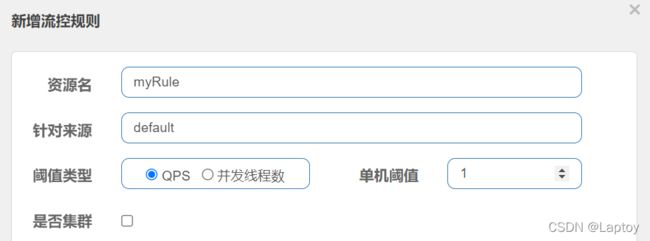
3、测试
访问 - http://localhost:84/consumer/fallback/1 (一秒内多次访问则限流)

这里不用异常作为变量 - 因为限流无法捕获java的异常,仍然会直接弹出异常页面,但如果限流策略配置异常数,达到阈值就会弹出自定义限流页面
3.14.5、配置fallback和限流
1、修改 - 控制层
@RestController
@Slf4j
public class CircleBreakerController {
@Resource
private PaymentService paymentService;
@RequestMapping("/consumer/fallback/{id}")
@SentinelResource(value = "myRule", fallback = "handlerFallback", blockHandler = "blockHandler")
public CommonResult<Payment> fallback(@PathVariable Long id) {
CommonResult<Payment> result = paymentService.paymentSQL(id);
if (id == 4) {
throw new IllegalArgumentException("非法参数异常....");
}
return result;
}
// 本例是fallback
public CommonResult handlerFallback(@PathVariable Long id, Throwable e) {
Payment payment = new Payment(id, "null");
return new CommonResult<>(444, "发生异常:" + e.getMessage(), payment);
}
// 本例是blockHandler
public CommonResult blockHandler(@PathVariable Long id, BlockException blockException) {
Payment payment = new Payment(id, "null");
return new CommonResult<>(445, "--限流 访问太频繁啦--", payment);
}
}
2、配置限流 - 每次重启服务这些配置都会消失,因为没有持久化

3、测试
访问 - http://localhost:84/consumer/fallback/1(访问一次)

访问 - http://localhost:84/consumer/fallback/1(一秒内访问多次)

访问 - http://localhost:84/consumer/fallback/4(访问一次)

访问 - http://localhost:84/consumer/fallback/4(一秒内访问多次)

4、结论
同时配置fallback和限流能够都生效,两层保障,进入限流的话fallback就被覆盖掉啦
3.14.6、配置exceptionsToIgnore
忽略指定异常,即这些异常不用兜底方法处理
1、修改 - 控制层(忽略非法参数异常)
@RestController
@Slf4j
public class CircleBreakerController {
@Resource
private PaymentService paymentService;
@RequestMapping("/consumer/fallback/{id}")
@SentinelResource(value = "myRule", fallback = "handlerFallback",
exceptionsToIgnore = IllegalArgumentException.class)
public CommonResult<Payment> fallback(@PathVariable Long id) {
CommonResult<Payment> result = paymentService.paymentSQL(id);
if (id == 4) {
throw new IllegalArgumentException("非法参数异常....");
}else if(result.getData() == null){
throw new RuntimeException("--这个星球找不到数据--");
}
return result;
}
// 本例是fallback
public CommonResult handlerFallback(@PathVariable Long id, Throwable e) {
Payment payment = new Payment(id, "null");
return new CommonResult<>(444, "发生异常:" + e.getMessage(), payment);
}
}
2、测试
访问 - http://localhost:84/consumer/fallback/4 (直接前台报异常)

访问 - http://localhost:84/consumer/fallback/5 (返回自定义回调)

3.14.7、配置降级
1、修改 - Feign层
@FeignClient(value = "nacos-payment-provider", fallback = PaymentFallbackService.class)
public interface PaymentService {
@GetMapping(value = "/paymentSQL/{id}")
public CommonResult<Payment> paymentSQL(@PathVariable("id") Long id);
}
2、新增 - 业务层 - 全局降级策略
@Component
public class PaymentFallbackService implements PaymentService {
@Override
public CommonResult<Payment> paymentSQL(Long id) {
return new CommonResult<>(44444, "服务降级返回,---PaymentFallbackService", new Payment(id, "errorSerial"));
}
}
3、新增- 控制层
@RestController
@Slf4j
public class DemotionController {
@Resource
private PaymentService paymentService;
@GetMapping(value = "/consumer/paymentSQL/{id}")
public CommonResult<Payment> paymentSQL(@PathVariable("id") Long id) {
return paymentService.paymentSQL(id);
}
}
4、YML
# 激活Sentinel对Feign的支持
feign:
sentinel:
enabled: true
5、测试
关闭服务提供者8003/8004
访问 - http://localhost:84/consumer/paymentSQL/1 直接触发降级
3.14、持久化规则
一旦我们重启应用,sentinel规则将消失,生产环境需要将配置规则进行持久化。
将限流配置规则持久化进Nacos保存,只要刷新8401某个rest地址,sentinel控制台的流控规则就能看到,只要Nacos里面的配置不删除,针对8401上sentinel上的流控规则持续有效。
1、修改 - cloudalibaba-sentinel-service8401
2、新增 - POM
<dependency>
<groupId>com.alibaba.cspgroupId>
<artifactId>sentinel-datasource-nacosartifactId>
dependency>
3、修改 - YML
server:
port: 8401
spring:
application:
name: cloudalibaba-sentinel-service
cloud:
nacos:
discovery:
server-addr: 120.76.55.55:8848 #Nacos服务注册中心地址
sentinel:
transport:
# 前台展示端口
dashboard: localhost:8080
# 后台监控端口
port: 8719
datasource: #<---------------------------关注点,添加Nacos数据源配置
ds1:
nacos:
server-addr: 120.76.55.55:8848
dataId: cloudalibaba-sentinel-service
groupId: DEFAULT_GROUP
data-type: json
rule-type: flow
management:
endpoints:
web:
exposure:
include: '*'
feign:
sentinel:
enabled: true # 激活Sentinel对Feign的支持
5、内容 - 这个是流控规则
[{
"resource": "/rateLimit/byUrl",
"IimitApp": "default",
"grade": 1,
"count": 1,
"strategy": 0,
"controlBehavior": 0,
"clusterMode": false
}]
- resource:资源名称;
- limitApp:来源应用;
- grade:阈值类型,0表示线程数, 1表示QPS;
- count:单机阈值;
- strategy:流控模式,0表示直接,1表示关联,2表示链路;
- controlBehavior:流控效果,0表示快速失败,1表示Warm Up,2表示排队等待;
- clusterMode:是否集群。
5、控制层 - 之前写的
@GetMapping("/rateLimit/byUrl")
@SentinelResource(value = "byUrl")
public CommonResult byUrl() {
return new CommonResult(200, "按url限流测试OK", new Payment(2020L, "serial002"));
}
6、测试
启动8401服务
先访问 - http://localhost:8401/rateLimit/byUrl (因为sentinel懒加载机制)
查看 - 控制台

重启 - 流控规则仍在(但是这种只能通过读取nacos的配置,在sentinel配置的流控规则仍然无法持久化)
